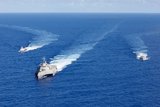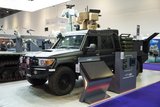How does the Five Eyes partnership enhance military interoperability?
Brought to you in partnership with Viasat
The Five Eyes partnership is best known as an intelligence-sharing arrangement. However, it has a crucial military dimension, binding key Western militaries together and acting as a force enabler for coalition operations.
The Five Eyes partnership of the US, UK, Australia, Canada, and New Zealand traces its origins back more than 80 years, to the Second World War and the Atlantic Charter.
Today, with the rise of peer rivals and a range of threats across the globe, it remains a vital resource, though one that must adapt to a shifting operational and strategic environment.
Enhanced military interoperability is a crucial advantage of the arrangement. Speaking at a Policy Exchange event in 2019, former Australian Prime Minister John Howard described his interactions with the UK and US intelligence agencies between 2001 and 2005, when Australia was involved in military operations in Iraq and Afghanistan.
‘The level of access that was available from MI6 and the CIA, and the confidentiality and the frankness, the candour of the briefings that I received … from the heads of those two agencies drove home to me on a personal level just how much it was seen as a special arrangement and the value of that arrangement’ to nations such as Australia and New Zealand, Howard said.
The US and UK developed the original arrangement during the Second World War. It was mainly based on sharing signals intercepts, noted John Parachini, Senior International Defence Researcher at the RAND Corporation. However, over time it evolved to include the three other countries.
The countries have ‘supported one another through a number of international conflicts, and have a similar approach to the business of national defence and intelligence, with an emphasis not only on protecting their nations but also on providing transparency where possible’, Parachini noted.
The arrangement has ‘very rapidly moved to encompass other forms of intelligence, human intelligence and covert action’, said Dr William Stoltz, Senior Advisor for Public Policy at the Australian National Security College.
The cooperation has expanded to include areas such as financial intelligence and law enforcement activities; there have even been Five Eyes statements on such themes as the Covid-19 pandemic.
‘There’s this desire to be able to leverage this unique and tight partnership of like-minded countries in a new way,’ Stoltz said.
So what does this evolving relationship mean for military interoperability? Craig Miller, President of Government Systems at Viasat, pointed to the culture of sharing between the five countries, in everything from language to behavioural norms.
‘That’s going to help in cooperation … because a lot of the problems of sharing data, coming to agreements on standards and what you share and don’t share, those are cultural aspects, and I think there’s a culture of sharing among the Five Eyes and a long history of that.’
The capacity for the countries to operate together has a range of practical military benefits, Miller said. He said it allows them to ‘act with a single imperative’ and be force multipliers for one another.
This will be particularly important in an age of growing peer rivalries with countries like China and Russia.
‘Our peer adversaries are so sophisticated, we’re not guaranteed to have dominance in all domains like we have in the past,’ he said. ‘In the past … we had dominance over land, air, sea, cyber, space. We’re not guaranteed to have dominance over any one of them at any given time in any given region.’
This will demand an ability ‘to flex and move and react’, said Miller. Interoperability can support this, with the ability to leverage each other’s resources being ‘the way that you’re going to prevail when you’re facing a peer adversary that can deny any given domain in certain regions at any time’.
However, it will pose significant challenges, he warned. There will need to be shared concepts of operations (CONOPs), while decisions will have to be made on the elements of the operational picture that are shared with one another.
‘We’re allies, but not everybody shares every single thing we’re doing, he said.

On a practical level, the allies will need to decide how to work together in terms of communications. This will demand decisions on using one another’s networks or allowing a terminal from one network to roam onto another, for instance. There will be a need for shared standards and agreements on how data is packaged and moved.
Against this backdrop, Miller said that heterogenous networking would play a key role. This concept – which Viasat terms hybrid networking – will bring different networks together and allow them to operate as a single network from the user’s perspective.
This could mean bringing a commercial broadband system like the ViaSat-3 satellite constellation together with the commercial broadband of other providers, for instance, or with purpose-built military satellites like the UK’s Skynet system.
‘To have a true, interoperable performance and to achieve multi-domain operations between coalition partners, and to share data effectively, there has to be a mechanism where these networks form a network of networks,’ Miller argued.
We have already seen the benefits of collaboration in the procurement sphere.
For example, Stoltz said there are capabilities – like nuclear-propelled submarines or aircraft like the Joint Strike Fighter – which are ‘beyond the technical reach of any one country, perhaps even the United States, and can only really be achieved by pooling the innovation, capital and resources of multiple countries’.
This approach is unavailable to a country like China, he said, ‘because it hasn’t built up those kinds of incredibly trusted relationships with other countries’.
Todd Harrison is Senior Fellow and Director of the Aerospace Security Project and Defence Budget Analysis at the Center for Strategic and International Studies (CSIS).
Harrison believes the priority to improve the intelligence-sharing arrangement is to ‘bring more eyes into the Five Eyes’, such as Japan, South Korea and Germany.
He also thinks the nations should look again at intelligence classification, classifying some intelligence at lower levels or even declassifying some.
‘Some of those discussions have to happen internally within each country, and some of them have to happen as a group.’
Could expanding the size of the group help the arrangement adapt to the rising powers and shifting operational picture the nations face today?

Paul G Buchanan, Director of 36 Parallel Assessments, a geopolitical and strategic analysis consultancy, noted that there are already countries who provide information to the Five Eyes and receive it in turn, without being full members of the arrangement.
‘Among those countries are countries like Israel, countries like Singapore, countries like Japan. There’s a number of them, and including them in the partnership might get unwieldy. But it depends on what full inclusion brings to the table.’
However, the potential benefits are evident. For example, there is a belief that Japan could offer a tactical window onto real-time events in China.
‘You’ve got five partners all working with the same equipment generally aligned in terms of their geostrategic interests. Very few other countries have those economies of scale, the machine working collectively on mutually agreed upon targets … it would have to be demonstrably proven that adding a full new partner would enhance capabilities in some way that they can’t obtain now. But the discussion is ongoing.’
What does the future hold for the Five Eyes and its contribution to military interoperability?
Viasat’s Miller points out that unlike the end of the Cold War, when the US gained an advantage by outspending the Soviet Union militarily, the next 30 years will likely see the Five Eyes nations confronting powers that are economic equals at the very least.
He argues that given this landscape, the Five Eyes nations’ ability to leverage the innovation fostered by the commercial sector will be crucial to regaining that economic advantage.
‘If you use commercial technologies as part of your portfolio of interoperable technologies, part of your networking technologies, and even part of your space technologies, then that brings back that economic superiority. And that’s going to have to happen.’
More from Studio
-
![Light Reconnaissance Strike – enabling a vital mission set (Studio)]()
Light Reconnaissance Strike – enabling a vital mission set (Studio)
A new system-of-systems concept will unlock digital integration of sensors and weapons for Light Forces, allowing them to shape the battlefield environment on their own terms and upgrade legacy platforms.
-
![Energy evolution: How laser defence systems are powering the next phase of air defence (podcast)]()
Energy evolution: How laser defence systems are powering the next phase of air defence (podcast)
Laser-based air defence is moving from promise to deployment as global threats evolve. In this special podcast, we explore how high-energy laser systems are reshaping interception strategies.
-
![Unlocking the potential of Light Forces in modern warfare (Studio)]()
Unlocking the potential of Light Forces in modern warfare (Studio)
The Ukraine conflict has highlighted the strategic importance of “Light Forces” – rapidly deployable dispersed units, able to conduct an expanding range of mission sets. What technologies and equipment are needed to ensure their success in combat?
-
![Resilience, adaptiveness and collaboration vital for success in space (Studio)]()
Resilience, adaptiveness and collaboration vital for success in space (Studio)
Speakers at the Defence In Space Conference (DISC) 2025 highlighted the critical and evolving role of space in national security, defence and the global economy.
-
![Precision on Demand: The New Age of Loitering Weapons (Podcast)]()
Precision on Demand: The New Age of Loitering Weapons (Podcast)
Loitering munitions provide vital capabilities in the disrupted and unpredictable modern battlespace, from real-time ISR to a virtually “on demand” strike capability. Rafael is looking to the future of the technology, empowering systems to operate with increasing autonomy in hostile environments.
-
![Beyond Survivability: How Active Protection Systems Are Empowering Commanders (Podcast)]()
Beyond Survivability: How Active Protection Systems Are Empowering Commanders (Podcast)
As threats diversify and intensify, APS are proving essential not just for vehicle protection but also for enhancing operational freedom, effectiveness and mission success in contested environments.




























